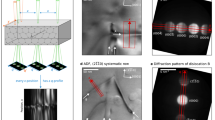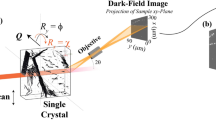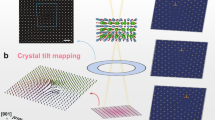Abstract
arising from C.-C. Chen et al. Nature 496, 74–77 (2013)10.1038/nature12009
At first sight, the achievement of determining atom positions in three dimensions appears spectacular1. Chen and colleagues1 apply a form of tomographic reconstruction to a tilt series of annular dark field (ADF) images of crystalline particles with defects, where the original data has a filter applied to reduce noise. However, the filtering imposes periodicities and significantly downgrades resolution, and the condition of signal linearity—a requirement for tomography—has not been met. We consider that their procedure gives an illusion of locating atom positions accurately. There is a Reply to this Brief Communication Arising by Miao, J. et al. Nature503,http://dx.doi.org/10.1038/nature12661(2013).
Similar content being viewed by others
Main
The experimental conditions (10.7 mrad beam convergence semi-angle at 200 keV) correspond to a resolution of about 0.23 nm, similar to that achieved in an earlier paper2, where the overall shape of the particle was reconstructed. The most useful information from a lattice is obtained from projections down the various crystal zone axes, along which atoms line up into resolvable columns. As shown in earlier work3,4, atomic resolution in ADF images is only possible when there is strong channelling down atomic columns. Simple geometry shows that a tilt of just 2° causes 7 nm columns, separated by 0.23 nm, to overlap each other in projection. Tilting from well-channelled conditions (zone axes) by only 2° generates significant intensity fluctuations, as shown in supplementary figure 1 of ref. 1, where bright and dark grains appear and disappear with tilt angle. This means that the key condition for tomography, that the recorded intensity be linearly related to projected potential, is violated.
When a channelled probe reaches a defect in a crystal, such as an edge dislocation, atomic columns become aligned with channels and vice versa. A well-channelled probe then encounters strong de-channelling conditions, resulting in loss of intensity. The effect is strongest in ADF images when the defect is close to the beam entrance surface5,6.
Information on the position of atoms around a defect with long-range strain is in the diffuse scattering, not the lattice reflections7,8. The procedure used in ref. 1 deliberately selects just the {200} and {111} Bragg peaks, and small regions around them (see figure 1b in ref. 1), suppressing essential diffuse contributions. In effect, this filter applies a point-spread function to each image, whose width is related to the inverse of the mask diameter around each reflection. This width, the resolution of the reconstruction, can be several times larger than the lattice spacing. It could be that essential diffuse scattering is lost in the noise, in which case this lowered resolution represents a fundamental limit on what can be achieved. Because the mask encompasses lattice reflections, the point-spread function is modulated by the lattice periodicity, giving the illusion of lattice resolution. Evidence for the downgraded resolution appears in supplementary figure 5c–e in ref. 1, which shows periodic ‘atomic columns’ outside the particle boundary. Although the procedure1 might still locate dislocations and grain boundaries, it does not necessarily put atoms in the right places because essential Fourier components are missing. This can be seen by comparing the atom positions in the rows immediately adjacent to the dislocation core in the model for the screw dislocation (supplementary figure 7b in ref. 1) and its reconstruction (supplementary figure 7d in ref. 1). Even when the noise threshold is set to 10%, there are still considerable displacements.
Some of the images presented1 show Moiré fringes, indicating that the contrast is not just a simple linear projection of the atomic density of each layer. This is particularly evident in figure 3a in ref. 1. The layers are about two unit cells thick, and it is unlikely that they all contain an extended in-plane stacking fault. The depth resolution is apparently much larger (poorer) than the slice thickness, allowing significant mixing of information between slices.
We agree that the method presented by Chen et al.1 identifies dislocations and defects in a crystal, but diffraction contrast alone can correctly identify the location and nature of dislocations6. The real challenge for tomography is to locate the 3D positions of all the atoms in an amorphous particle. We consider that the claims made1 for the tomographic method on a crystalline particle are not appropriate; it is not a true 3D reconstruction giving precise atomic positions.
References
Chen, C.-C. et al. Three-dimensional imaging of dislocations in a nanoparticle at atomic resolution. Nature 496, 74–77 (2013)
Scott, M. C. et al. Electron tomography at 2.4 Å resolution. Nature 483, 444–447 (2012)
Jesson, D. E. & Pennycook, S. J. Incoherent imaging of crystals using thermally scattered electrons. Proc. R. Soc. A 449, 273–293 (1995)
Hillyard, S., Loane, R. F. & Silcox, J. Annular dark-field imaging: resolution and thickness effects. Ultramicroscopy 49, 14–25 (1993)
Treacy, M. M. J. & Gibson, J. M. in Electron Microscopy and Analysis 263–266 (Institute of Physics Conf. Ser. No. 61, 1981)
Hirsch, P. B., Howie, A., Nicholson, R. B., Pashley, D. W. & Whelan, M. J. Electron Microscopy of Thin Crystals 165–193; 222–275 (Butterworths, 1965)
Rez, P. The Theory of Inelastic Scattering in the Electron Microscopy of Crystals. D.Phil. thesis, Oxford Univ. (1976)
Anstis, G. R. & Cockayne, D. J. H. The calculation and interpretation of high-resolution electron microscope images of lattice defects. Acta Crystallogr. A 35, 511–524 (1979)
Author information
Authors and Affiliations
Contributions
The authors contributed equally.
Corresponding author
Ethics declarations
Competing interests
Declared none.
Rights and permissions
About this article
Cite this article
Rez, P., Treacy, M. Three-dimensional imaging of dislocations. Nature 503, E1 (2013). https://doi.org/10.1038/nature12660
Received:
Accepted:
Published:
Issue Date:
DOI: https://doi.org/10.1038/nature12660
This article is cited by
-
Three dimensional classification of dislocations from single projections
Nature Communications (2024)
-
Formation of bimetallic clusters in superfluid helium nanodroplets analysed by atomic resolution electron tomography
Nature Communications (2015)
-
Miao et al. reply
Nature (2013)
Comments
By submitting a comment you agree to abide by our Terms and Community Guidelines. If you find something abusive or that does not comply with our terms or guidelines please flag it as inappropriate.



